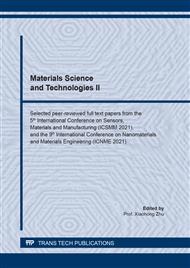p.3
p.9
p.15
p.21
p.33
p.39
p.45
p.51
p.57
Research Progress on Adsorption of Water Pollutants by Nano Materials
Abstract:
With the development of nanotechnology, nanomaterials, as a key emerging material, are more and more widely used. The basic structure of nanomaterials determines that they have strong adsorption capacity. Therefore, nanomaterials have a wide application prospect as adsorbents to remove pollutants in water environment. This paper summarizes the relevant research data at home and abroad in recent years, briefly introduces the functions of different kinds of nanomaterials, summarizes the application of nanoadsorption technology in sewage treatment, and explores the adsorption mechanism of various nanomaterials on various pollutants in water, At the same time, the research progress of several common nanoadsorption materials in removing water pollutants is summarized, and the risks existing in the application of nanomaterials are pointed out. On this basis, the development direction of nanowater treatment technology is prospected.
Info:
Periodical:
Pages:
33-38
Citation:
Online since:
April 2022
Authors:
Keywords:
Price:
Сopyright:
© 2022 Trans Tech Publications Ltd. All Rights Reserved
Share:
Citation:



